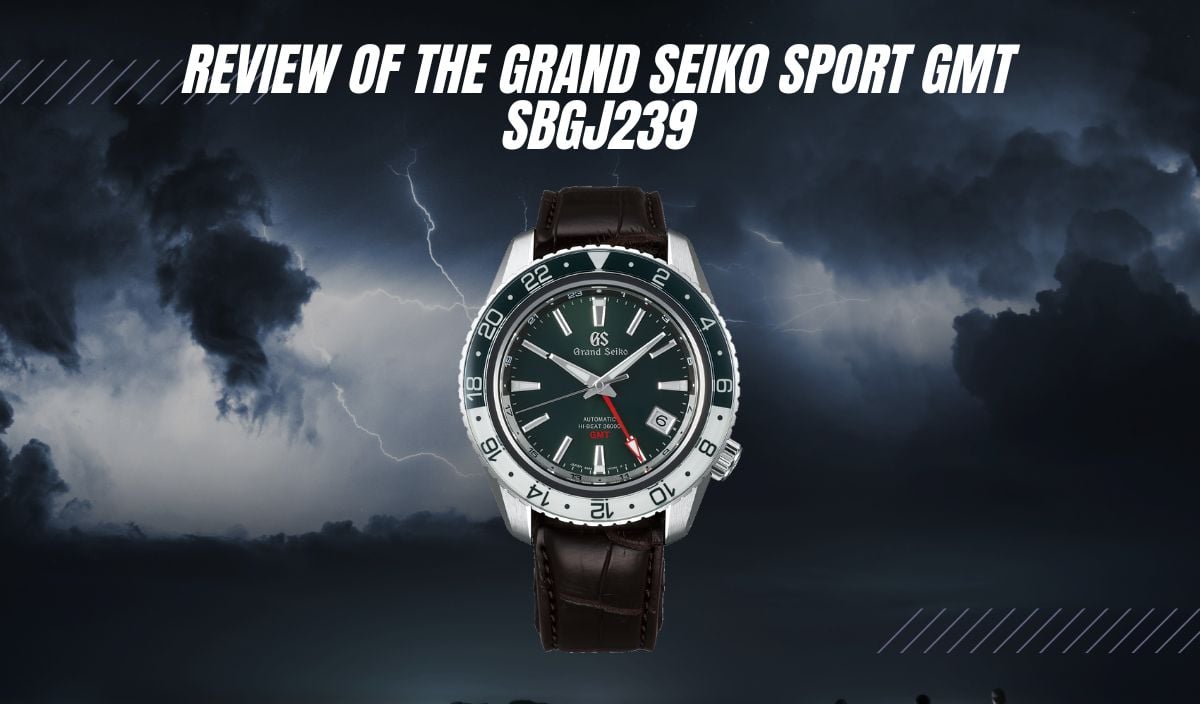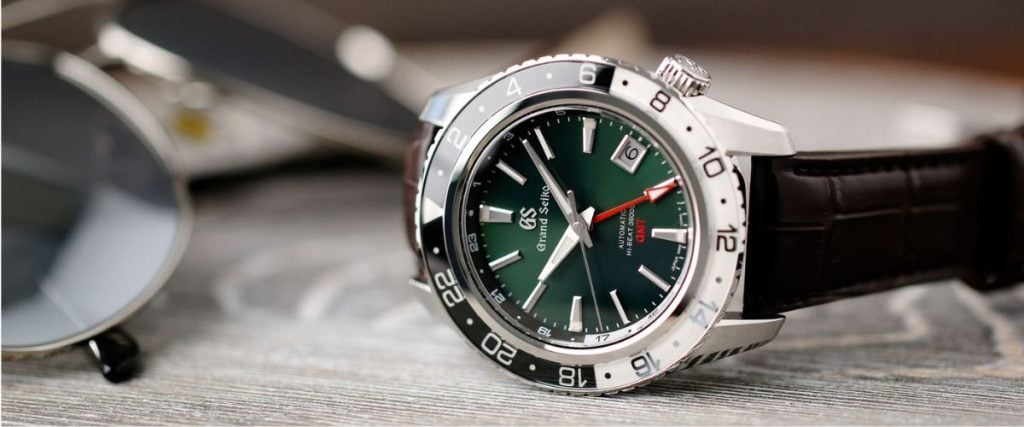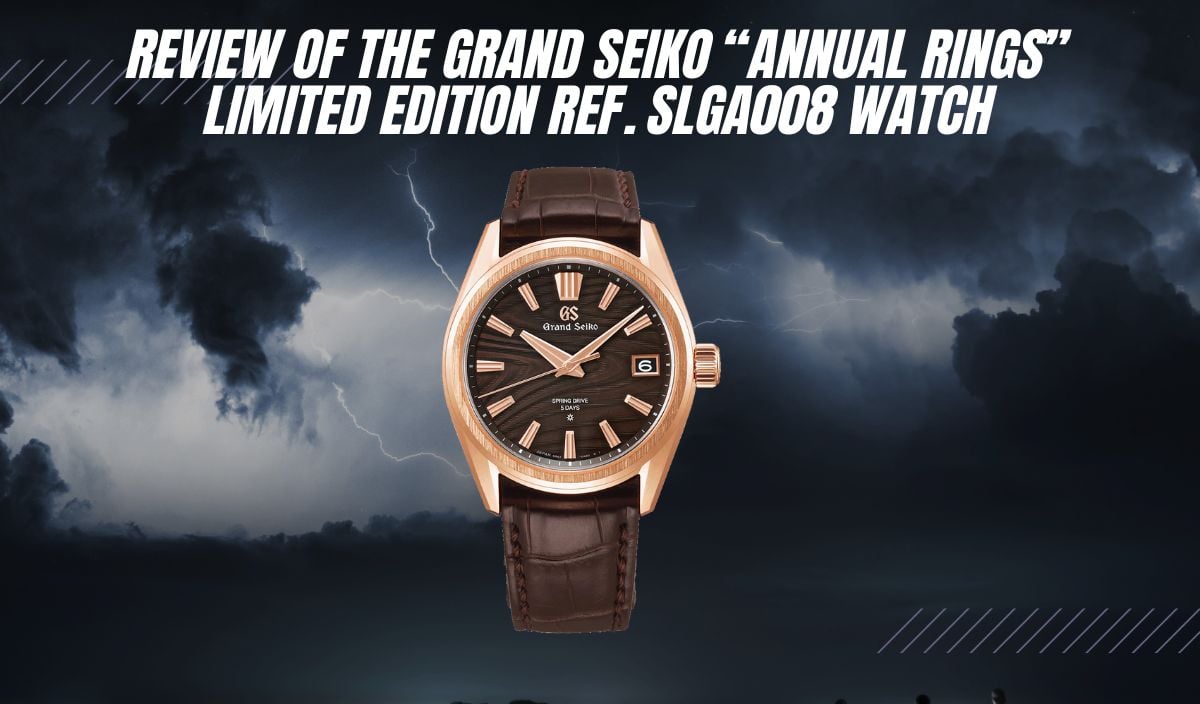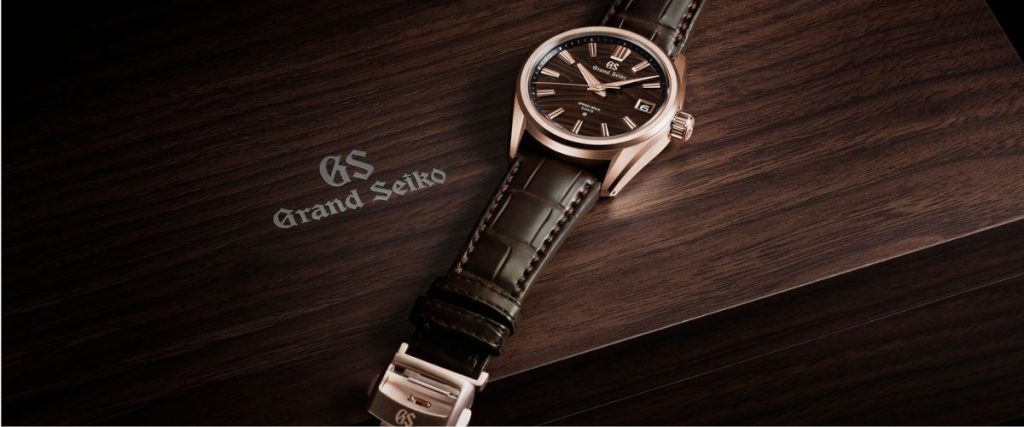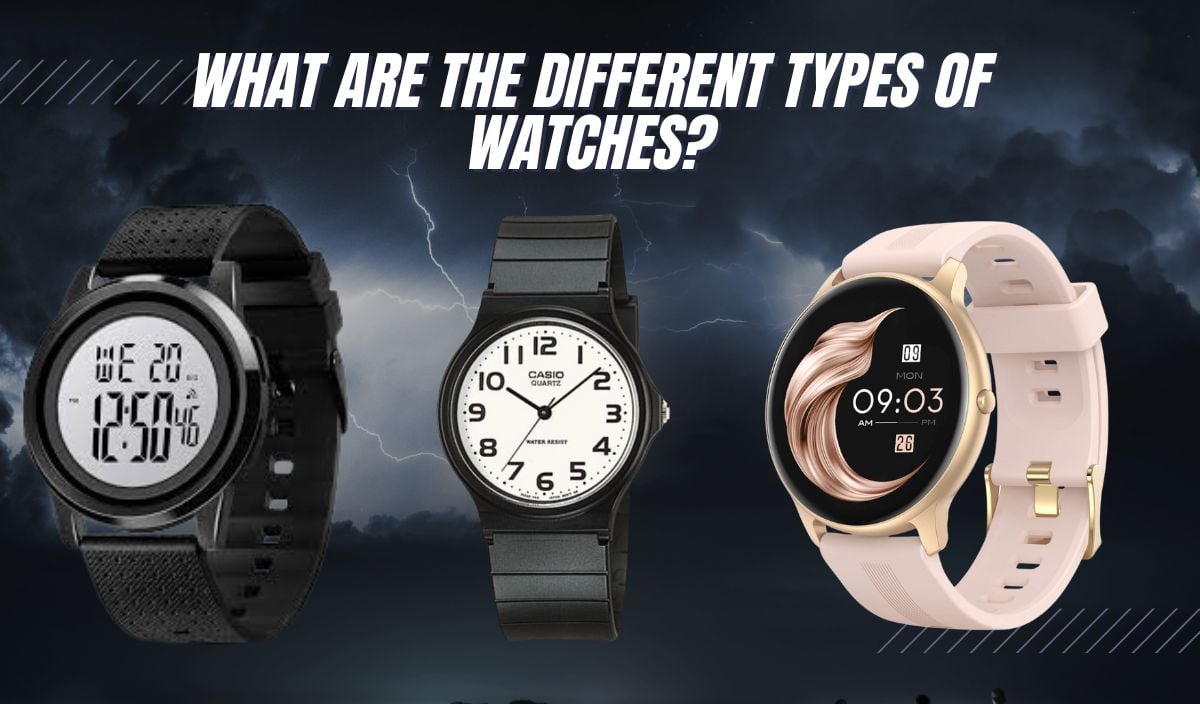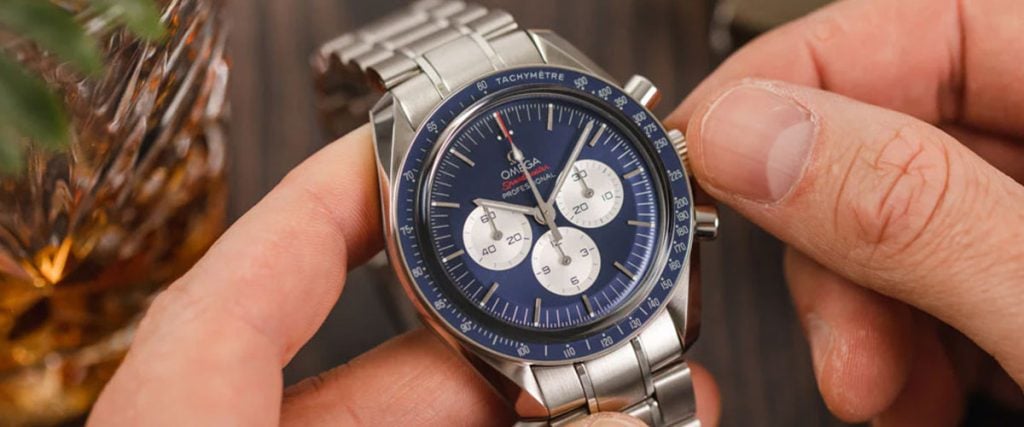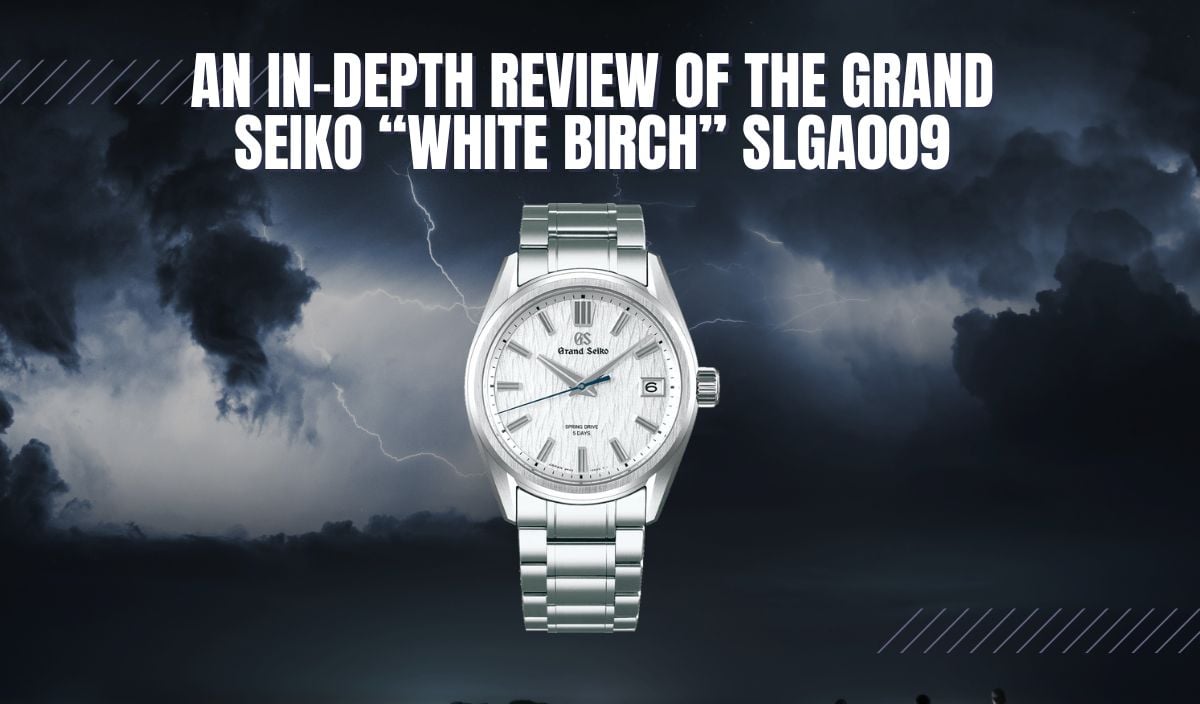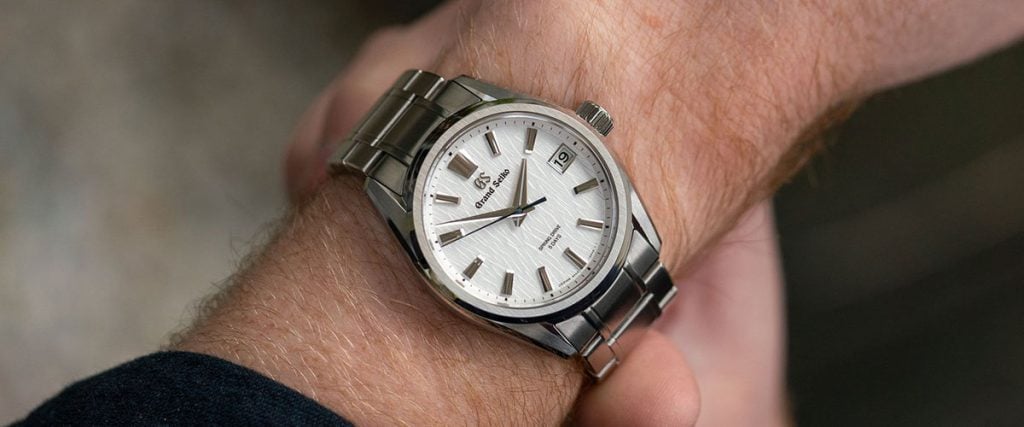
The Grand Seiko SBGC251 is a watch with staying power. Once you get some hands-on experience with it like I did, you’ll begin to appreciate all it offers. This is a watch that combines a GMT complication for travel with a sporty chronograph.
Moreover, the chronograph counters are not presented in your typical 3-6-9 format. The unconventional dial layout is one of its most striking features, along with a lightweight, high-intensity titanium case and sophisticated Spring Drive movement, of course. Before I share what I think about the SBGC251, let’s look at where the design came from.
About The Evolution 9 Series
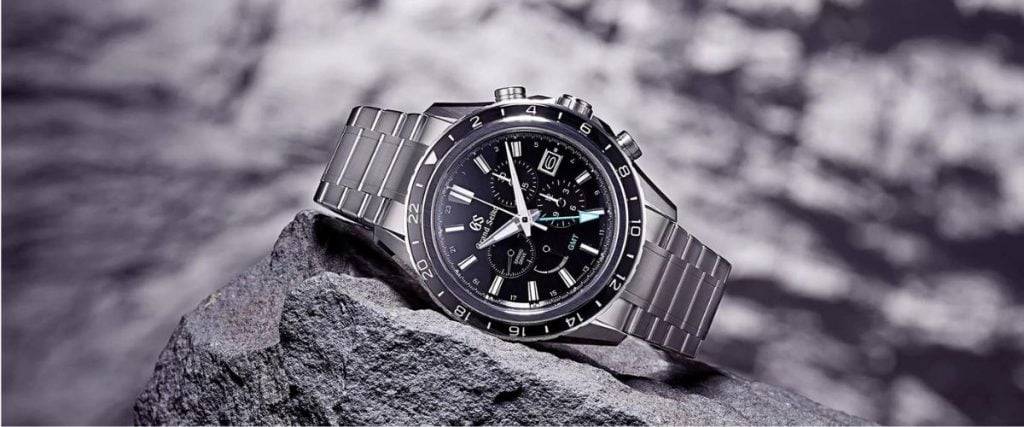
The SBGC251 was released back in 2022 as part of the Japanese brand’s Evolution 9 Collection, which launched a couple of years earlier. For those who don’t already know, this collection represents one of the biggest launches of the company’s entire history.
To me, the watches from this series are all wish-list-worthy designs. They capture the traditions and landscapes of the brand’s finest practices. A culture whereby every creation since the company’s founding year of 1967 is inspired by its heritage or the nature surrounding it.
Sometimes Evolution 9 watches take inspiration from the changing seasons throughout the year – maybe a delicate blossom, caught gently floating in the spring breeze or the crisp, white snow-dusted mountains that form a backdrop to the manufacturer’s ateliers.
Aside from capturing these natural phenomena, the collection is also home to sportier timepieces and travel companions. In fact, the SBGC251 is a combination of both. Its chronograph functions meld with a GMT complication to provide you with a tool that can be worn at the gym, in the office, or when traveling on business.
The launch of the Evolution 9 Series a few years ago signified characteristics like a curved case, a more robust bracelet, and wider lugs. The brand also decided to make the hands of these watches bolder for greater legibility at night and even created a new font for the numerals on the bezel. All watches within this collection represent an updated version of the familiar Grand Seiko DNA and take inspiration from the original 44GS series.
The SBGC251 Takes Inspirational Cues from the 44GS
The 44GS is the model responsible for shaping the quintessential “Grand Seiko Style” and marked a pivotal point for the brand in terms of its approach to design.
The story goes a little like this. Before the birth of the 44GS watches in 1967, every Grand Seiko watch looked different from the next. While this lack of consistency wasn’t exactly a problem, what the brand wanted to achieve was a watch with a distinctive identity. Grand Seiko wanted to be recognized for an identifiable design language. A young designer had the answer to this.
Taro Tanaka established a new standard for aesthetics that would run through the core of the brand’s catalog like strands of DNA. The criteria gave each watch an instantly recognizable look and a set of features that could be mistaken for no other watch on the market. This grammar of design was known as the “Grand Seiko Style” AKA the 44GS.
The 44GS took its name from the 44GS Calibre, or the 4420 to be more precise. Having led a very successful 50-year run, the design aesthetics that define this look are still as important to Grand Seiko collectors and the brand itself today.
In fact, you could say it has influenced pretty much every Grand Seiko watch released ever since. The 44GS introduced geometric elements, flat surfaces, angles enhanced by meticulous case finishes, sharp flanks, and geometric silhouettes. Intrigued? We’re going to look at some examples of these design elements in this review of the Grand Seiko SBGC251.
The Case
I mentioned earlier that the Evolution 9 Series, of which the SBGC251 belongs, is inspired by the 44GS and examples of this can be appreciated as you peel back the layers of this design and uncover its hidden details. Uniquely, the Grand Seiko Style can be recognized for its two-dimensional curves and flat surfaces that make up the distortion-free case, lugs, bezel, and case sides of the reference SBGC251.
Tanaka clearly took a bold step away from the conventional rounded case when developing this set of criteria. Instead, he focussed on inward and outward angles to define the Grand Seiko case and bezel that we have all come to know and love today.
I think these small details are the most important overall. The angles of the case, bezel, and lugs reflect the light in so many different ways on the wrist. In a way, they kind of act as a metaphor for Grand Seiko’s multifaceted skills in craftsmanship. The beautifully carved elements follow through into the hands and hour markers of the dial, perpetuating the brand’s pursuit of perfection.
Now, make no mistake, this is a large watch. Its 45mm case is crafted from high-intensity titanium – a material that is interchangeable with grade 5 titanium. It sits at a depth of 16.3mm, and from lug tip to lug tip, it measures 52.3mm. There are several 44GS styling elements seen throughout the case. The pointed multi-faceted lug ends with both satin and polished finishes are one example. The polished parts feature the optically smooth mirror finish that is known as Zaratsu polishing.
Earlier, I spoke a little about the period before Tanaka birthed the idea of the Grand Seiko Style. The Japanese brand had already won several awards for precision by the 1960s, but the identity of a Grand Seiko watch case had not yet been established, and this is really where the Zaratsu polishing technique came into play. Tanaka realized very quickly that while Grand Seiko watches were perfect as an individual design, they needed an identity and more brilliance.
Many prototypes were created before reaching the distortion-free, brilliant mirrored finish we all come to associate with the brand today. Zaratsu polishing was the solution to achieving a perfectly flat surface.
Buffing simply wasn’t enough since it softened the angles that technicians had worked so hard to create. Zaratsu was the missing ingredient in the Grand Seiko recipe. The technique follows the rough buffing and sanding process after a case is carved and sculpted, not to mention stamped with several hundred tonnes of force – a process that requires an expert skill level.
Zaratsu takes the name of a European company that created a special machine by which the case of a watch is polished to an incredibly high standard. The flat surfaces of a case can be polished using this machine by holding it up to the wheel rather than at the side.
The rotating metal wheel is capped with sandpaper and requires a steady hand and keen eye to achieve its special surface finish. The smallest change in pressure by the hand of the craftsman can change the outcome of the case drastically. Thus, the process requires a significant level of intuition. The process is completed with a final buff, again dependent on the craftsman’s sense of touch.
The case of the Grand Seiko SBGC251 is 100-meter water resistant and is upheld by the help of a Grand Seiko-stamped screw-down crown at 3 o’clock. The crown is executed in a mix of polished and blasted finishes, similar to the buckle logo, while the bezel is sharply knurled to provide an easy grip under the fingertips. This is one of my favorite features in a Grand Seiko watch.
The finish on the bezel knurling is where you can really appreciate the level of detail in a watch like this, priced at just under the $12k mark. The bezel glides beautifully under a Teflon undercoating, while the top is executed in glossy black color, capped with sapphire glass for a more refined finish. This GMT 24-hour bezel can be used in conjunction with the blue GMT hand to track a third time zone, providing a very handy feature for those having to gauge time zones for business purposes.
The Dial
The hands and hour markers on the dial of the Grand Seiko SBGC251 shine like a diamond. They enhance legibility to no end. Compare this to a simple handset from a Tissot, for example, and the difference is noticeable. The sharp, angular sword-shaped hands entice light to play along their edges while at the same time utilizing flat surfaces for maximum impact. Grand Seiko has done well in creating a highly legible dial by night, too.
The application of the luminous material on the hands and hour markers can’t be faulted. The pill-shaped hour markers illuminate in a rich green glow, as do the main hands, while the triangular tip on the GMT hand and the 24-hour bezel boast a vibrant blue emission.
The constant seconds on the left side of this handcrafted dial is accompanied by a 30-minute chronograph sub-dial at 1:30, chronograph hours counter at 4:30, and a handy power reserve indicator nestled between 7 and 8 o’clock.
In other Grand Seiko reviews, we’ve talked about the appeal of the power reserve indicator and the brand’s decision to relocate it to the back of the case in some of the company’s Seasons Collection watches, like the White Birch. I feel that this design looks in proportion to the rest of the dial. I love the unconventional location of the sub-dials in this watch. They’re not only quirky but give the dial a technical look too.
The Movement
It is the movement of this Grand Seiko watch that fascinates me. For its price point, it offers great visual depth through a see-through caseback. You can quite easily become entranced with the Spring Drive movement and its level of finishing. It’s incredibly impressive. Grand Seiko’s technology is nothing short of beautiful.
The Calibre 9R36 is one of the world’s most accurate chronographs. With the ability to measure elapsed time to the nearest fraction of a second, this Grand Seiko chronograph is perfect for calculating speed and distance. It promises an accuracy of +15 seconds a month, or -1 second a day, and comprises 50 jewels for a smooth performance.
The Spring Drive movement works with the use of the Tri-synchro regulator and a thermo-compensator to check for temperature fluctuations throughout the day. A quartz crystal regulates an electromagnetic braking system, combining mechanical and quartz-powered benefits in one design. The Spring Drive Calibre 9R36 inside the SBGC251 watch offers a power reserve of 72 hours and is what gives the seconds hand an effortless gliding motion.
The Strap
The lug width of the Grand Seiko SBGC251 measures 23mm, and the bracelet is crafted from the same high-intensity titanium as seen on the case. If you take a closer look at the shoulders of the links, you’ll see a nice, polished finish, which I think is what elevates the timepiece to a dressier aesthetic so perfectly.
The top of the links boasts a satin effect for added contrast against the polished edges, while pins and sleeves are used for the construction of the bracelet. It’s what we tend to see in all titanium bracelets made by Grand Seiko. Several holes are drilled in pairs on the clasp to offer anchoring points for re-sizing.
The titanium buckle has a single-fold design with a twin-trigger release mechanism. The logo is also done very tastefully on the buckle. It’s a nice mix of polished and sandblasted finishes, which I feel enable it to stand out crisply. The lugs of the case have strap tool holes, which easily dismount the strap or bracelet when using a strap tool.
Generally speaking, these are rare in watches within this price bracket on the Swiss market. The fact that Grand Seiko makes strap changes so simple and easy is an added bonus. You can change the aesthetic of the reference SBGC251 simply by changing the band, depending on whether you want something sporty, classic, or dressy. I love this about Grand Seiko watches. A watch that easily transforms with a quick strap change is surely great value for money, right?
How It Wears
The SBGC251 measures a broad 45mm diameter, and while the lightweight titanium material of the case compensates for its heftiness, it is still a large watch. If your wrist measures 6.25 inches, you may struggle to carry this watch off aesthetically. Larger than 6.25-inch wrists, however, shouldn’t have too much of a problem. If you love the watch but you’re unsure whether your wrist can pull it off, you’d be better off switching out its titanium bracelet for a leather band.
The watch carries some thickness too, so it won’t easily slip under every cuff. Worn with a jacket, however, this Grand Seiko watch really comes into its own. In fact, I’d go as far as to say the watch was made for the jacket-wearing type of collector. Does it look good with a leather jacket? It certainly does. A bomber jacket? Absolutely.
That said, you can easily go more casual with this Grand Seiko watch too. The black dial and baby blue GMT hand lend themselves to a very versatile wardrobe. On the whole, this is an aggressive, sporty model with multifunctional uses, so it makes sense that Grand Seiko made it versatile enough to wear in different attires.
A thinner case would make this watch fit a little better, but all in all, there is plenty to love about this watch and very little to nitpick at. So long as you have the wrist size to carry it, this Grand Seiko watch is ergonomically designed for comfort, style, and functionality. It’s the kind of watch I would easily place inside the “wear-it-till-you’re-dead” bracket, and that’s mainly due to its classic black design, useful complications, and lightweight construction.
The Price
While for many, a Rolex is the ultimate grail and is considered by many as one of life’s greatest accomplishments, Grand Seiko offers something that a Rolex simply cannot – affordability. The SBGC251 is priced at $11,400 at Exquisite Timepieces and gives you plenty of bang for your buck.
Not only does the watch offer an in-house movement and a multi-complication design (a combined GMT function and chronograph dial), but its Zaratsu case polishing is a genuine handcraft that takes years to master and hours to complete. You’d struggle to find a watch with a similar level of hand-applied execution as this for the same price point.
Conclusion
The familiar design language of the Evolution 9 Series by Grand Seiko is something that can either be amped up or diluted down depending on the design. The sculpted nature of the watch really impresses me, and it’s something that I’ll always remember about the design, having had some hands-on time with it. Sure, the watch certainly wasn’t made for my female wrist.
But I can certainly appreciate the kind of “wear it ‘til the end” design that a sports watch collector may be looking for. The GMT function is going to come in handy whether you travel frequently or just want to track friends and family in another time zone and want to schedule a quick phone call.
I very easily (and quite quickly) grew a fondness and respect for the SGBC251. As so often is the case, I barely realize I have, until the time comes to hand it back over. Though I can’t carry its proportions on my wrist, it offers everything a male collector needs in a daily beater. Functionality, reliability, and style.
It’s the kind of watch that you could easily forget you’re wearing but in a good way. At the same time, it’s still an interesting enough design to keep one’s watch enthusiasm alive. You can check it out in some more detail here at Exquisite Timepieces.









